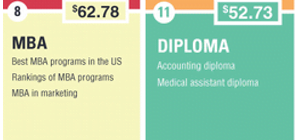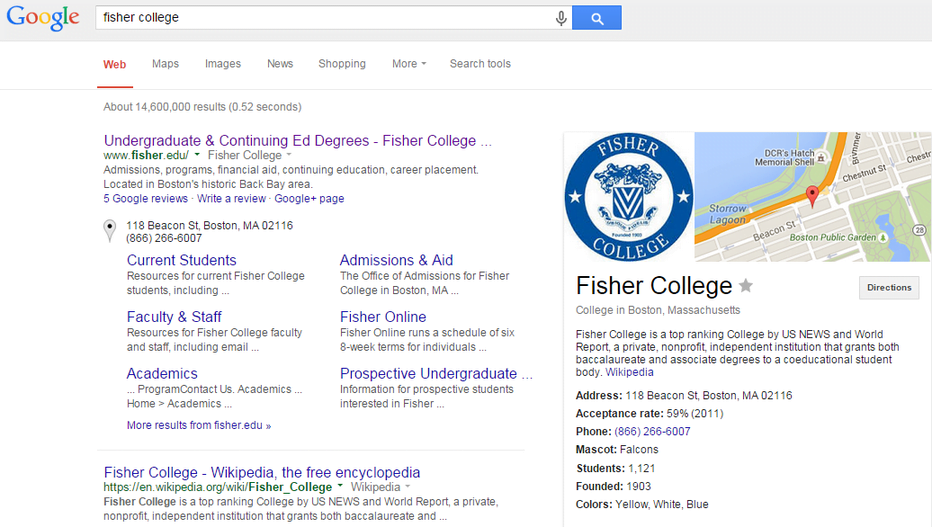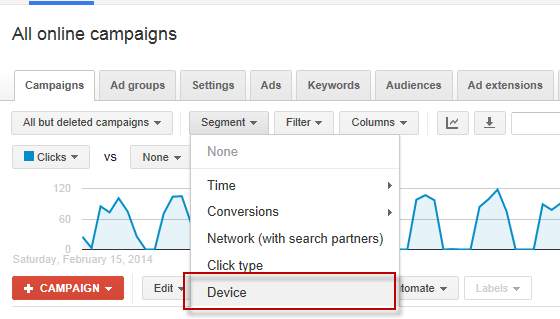
Can you recall the path you took when applying to college? You probably didn’t hop on Google, type “best colleges near me,” and hit “apply now.” Let’s be honest, the internet likely wasn’t even around when you applied for college!
Jokes aside, the way we market to potential students continues to evolve in line with technological advances, at a rapid pace. With search engines playing a big role in the research phase, and mobile becoming more important than ever before, marketers in higher education need to keep up!
Don’t hate me for saying this, but summer is coming to a close before we know it… It’s the sad truth and with the end of summer excursions and long days at the beach, prospective students are starting to think about their futures, searching for more information on educational programs, and potentially applying to make September deadlines. However, education marketers face a handful of dilemmas when it comes to PPC.
Let’s explore the top challenges marketers working in this unique vertical face:
Education Industry PPC Challenges
Keywords are Expensive!
Education is a universal desire and often a requirement to survive and thrive in today’s society. With a market so big, as one would expect, keywords don’t come cheap. Just take a look at the suggested bid price when I threw a few degree-related keywords in Google’s Keywords Planner.
Yikes! When paying $40+ per click, you want to make sure that click is worth the money rolling out of your Google Ads (AdWords) account.
In a recent WordStream study, MBA-related keywords ranked as the 8th highest costing category of keywords in Bing. Searches like “Best MBA programs” and “MBA in Marketing” can cost over $60 per click. Diploma-related keywords don’t fall far behind, costing over $50 per click on average.
Sales Cycles Are Long & Hard to Control
In terms of converting applicants, many factors are likely out of your control. High school students applying are often easily influenced by their peers, and just generally don’t have a clue of what they want. Do you remember your mindset at 18? Point proven.
When applying to college, I looked at schools based on what my parents, guidance counselor, and friends discussed, not so much what I found online and logically considered through independent research. The requirements I had included a beach nearby, an active social scene, and a small class size. So many colleges fit into this mold, so just being #1 on the SERPs isn’t necessarily going to get you more applicants.
This is not to say you should dismiss the value of search (after all, you need to consider the technology-driven world we live in), but you do need to consider many more factors like reputation, positive press, local events (college fairs), and creating alumni brand ambassadors to spread the word.
Advertisers Need to Be Aware of Regulations
Before 2011, it was easy to get away with almost any keyword in your ad text, but Google put regulations in place banning schools (specifically state schools) from using words like “employment” in their ads. Why? Because Google doesn’t want education providers misleading the user to believe employment is going to be provided, so jamming your copy with job-related keywords is not an option unless you want a potential lawsuit on your hands.
“Stay in compliance when it comes to ad messaging,” advises Hanapin’s Jeffrey Baum. “Stuffing keywords at the expense of potential fines and lawsuits is not worth the risk.”
So, what can you do to address all of these challenges, and actually gain qualified applicants through Google? Let’s dive into the seven tactics every higher education marketer should be using to succeed with PPC.
#1: Don’t Bid on Branded Terms
Typically I recommend that bidding on your own brand terms is worth the investment. Costs are usually low, CTRs are high (leading to higher Quality Scores and lower prices), and it prevents the chance of your competition outbidding your own brand. However, with education, things are different. People who are already students at a school are going to use Google to get to its site.
WordStream client Adam Higgins, marketing manager at Fisher.edu, learned this the hard way.
“Unlike other businesses, you can get a lot of current customers, faculty and staff who use the website as their prime portal for resources,” Higgins says. “Students Google ‘Fisher College,’ click on the paid ad, and then you pay for those clicks without conversions to justify the cost.”
Likely, you’re already going to show up in a branded search, so don’t waste your budget on searchers who have already converted. With keywords already costing so much, you need to prioritize campaigns that will yield return.
As you can see, Fisher College is already dominating the entire top half of the page organically on Google.
#2: Focus on Your Most Relevant Audience
With high prices, and typically tight budgets, you need to focus on the audience that you are most likely to gain a profit from with paid search. Adam realized that targeting high school students isn’t the best strategy, so he shifted his entire PPC technique to cater specifically to continuing education applicants.
“We do some advertising towards college applicants, but 9 out of 10 times our copy is geared towards continuing ed,” says Adam. “Coming out of high school this audience is already getting information delivered directly to them, and therefore doing less comparative shopping-style research. Rather they tend to come in organically because they’re doing branded searchers like ‘ok, my guidance counselor recommended these three schools.’ When the adult learner is like ‘I have no idea…’”
Adam goes on to explain that the few ads that he gears towards high school students applying for college are completely different then the higher education ads.
“For college applicants we’ll write things like, ‘It’s a blast in downtown Boston,’ type deal, but with continuing education we put a higher focus on time management, convenience, and flexibility.”
This shows how critical it is to put yourself in the shoes of your searcher when writing your PPC ad copy.
#3: Build Your Account Structure Around Specific Programs Rather Than General Keywords
The structure of your Google Ads account is one of the most critical components when it comes to paid search, and for those marketing colleges, private schools for children (to parents), or any other continuing education programs, the best way to entice the most relevant leads that are more likely to convert is by structuring around the programs you offer.
This might seem obvious, but the mistake has been made where education marketers bid on general terms like “bachelor’s degree” or “MBA” and end up wasting tons of money because the search isn’t specific enough.
“People who are doing research in the education space are doing so based on a specific program,” says Adam. “No one is just Googling ‘associates degree’ or ‘graduate degree,’ but rather their interest lies in a specific field of study like ‘nursing program,’ etc.”
The queries that convert are often not attached to general degree type keywords, but rather to more concentrated fields of study since the searcher’s intent is much more focused.
As the advertiser, you need to ensure your campaigns are structured around the programs you offer. For example, a nursing campaign may contain ad groups such as “nursing program (general),” “pediatrics nursing program,” or “becoming a hospice nurse.” Then each ad group should have a small set of keywords related to that theme, paired with ads and landing pages that speak to the specific program the searcher is looking for.
#4: Cater Your PPC (and Social) Strategy to the Top-of-the-Funnel Searcher
In the education industry, people who are searching for schools and opportunities to obtain a degree or simply take a class typically start on search with top-of-the-funnel-style research. Once they’re moving down the funnel, it’s less likely for someone to hop on Google, rather than go directly to the business’ site. This is why focusing your keyword bidding, ad copy, and landing page strategy with these top-of-the-funnel searchers in mind is critical.
Adam suggests focusing on a more content-heavy approach to warm these people up and inform them rather than directing them to an “apply now” page. This will just scare them off.
“Be cognizant of where they are in the funnel,” Adam says. “I take a content approach since where they are is very casual at that point. They might be willing to fill out a short form, but I always steer clear of more aggressive offerings.”
This is even more important to emphasize with educational social ads.
“No one is scrolling through their social feed and is like ‘oh, let me apply for a serious degree,’” says Adam. “These people are even further away from the funnel then those going through search.”
Adam has seen success taking a content approach on Facebook, and he’s also taken advantage of the advanced targeting options available.
“The beauty of social media is that there’s so much data on clicks, behavior, interests, etc., that you can find the exact audience you want to target.” Adam has found lots of success promoting informational blog content with CTA’s at the end of the piece. “I once chose a relevant hot topic, turned it into a blog article, plugged a form fill out at the end, and ended up spending $400, which got us 11 conversions at a low CPA of $36,” he says. “If you’ve got the content, social media can be very powerful, but if you’re going with a sales heavy approach it’s never going to work.”
#5: Find the Sweet Spot for Form Fill-Outs
Going along with the top-of-the-funnel audience that typically comes in through search, education marketers need to be cautious to not scare away PPC leads with long forms.
“In the higher ed world, we want to get as much data about these people as possible, but it’s important to find the right amount of information to ask,” says Adam. “When I started out with 12 questions I had to change that to ask the bare minimum. Twelve was too overwhelming for the leads coming in through search.”
Once these leads are captured through search, Adam reaches out to nurture via remarketing, email, sending articles, e-books, etc.
“You’ve got to remember these people can get scared off easily,” Adam says. “I’ve seen what happens when you send a hard sell email vs. blog article, and hands down content wins.”
Adam said that when he’s tried hard sells in the past he’s received less than 1% response rates, but with content, he would get 10% or higher.
#6: Prioritize Mobile Friendliness
Mobile, mobile, mobile – yes, we understand it’s important! But how important is it for the education industry? According to Adam, very!
“During certain periods we’ve seen as high as 80% of our traffic is coming from mobile,” he says.
So, what should you do to optimize for mobile? Here’s a few steps to get started…
- First, look at YOUR data! Segment by device in Google Ads to see how much of your traffic is coming from mobile. Dig into Analytics to see the cross-device behaviors of your visitors. Grasp an understanding of your mobile audience before making major changes.
- Ensure your site is mobile friendly. Pull up your homepage, prime PPC landing pages, contact us page, etc., and see how they appear on your iPhone or Android. Are you doing a lot of zooming in and squinting at the screen? Then you might need to work on overhauling your site to make sure the mobile experience doesn’t turn your on-the-go searchers away.
- Adjust mobile bids. If you are indeed getting most of your traffic through mobile devices, like Adam is, you’re going to want to bid significantly higher on mobile devices.
- Optimize your ads for mobile searchers. Use quick, to-the-point copy, ensure ad extensions are set up, and forms are short.
#7: Boost Budget for Prime Times in Summer & Winter
The end of summer always marks the time to gear up for the yellow school buses lining the streets and local town traffic clogging the roads at 7:00 AM and again at 2:00-3:00 PM. Naturally, our minds are programed to connect education with September. This leads to the highest levels of traffic for educational searches on Google typically peaking in July and August.
Whether it be a parent hunting down a school to send their child to, or a middle-aged worker looking to enhance their professional background, education is on the mind. The same goes for winter, specifically January.
“August and January are always the two biggest enrollment periods, so we always boost our budgets for those months,” says Adam. “Although I do run our ads all year around because we have so many continuing education applicants and six starts throughout the year so I see conversions go up and down on a cyclical basis. Yet, still August and January are always our highest traffic months.”
There’s still time to get your PPC strategy up-to-speed for the beginning of the school year, so follow these tips and prepare yourself for an uptick in applicants.












